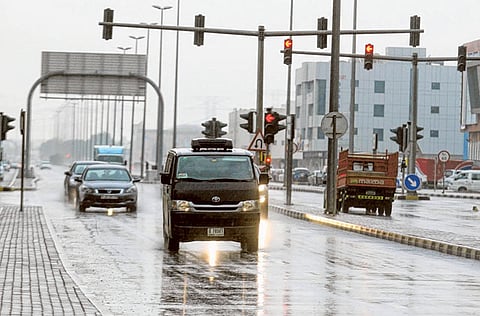UAE rains: Reckless driving can get you hefty fines, how to drive safe
Abu Dhabi police posted a video warning motorists about reckless driving in rains

After an evening and night of rain, motorists are expected to be extra careful while traversing roads in the UAE.
Abu Dhabi Police posted a video on their social media channels warning motorists that strict action would be enforced if someone was found to be driving recklessly. According to UAE laws, any action classified as 'reckless driving' can land you with a hefty fine of Dh2,000 in addition to piling on 23 black points and impounding of the vehicle for a period of 60 days.
Rainy weather can be a very serious problem to drivers as reduced visibility makes spotting hazards much harder, not to mention slippery roads. For better road safety, there are certain things to observe when driving in the rain.
Only drive if you have to
If you wake up to a rainy day then the best thing to do is send a text message (even a picture message) to your boss telling them that you are going to be late in. Your safety is the most important thing, so wait for the rain to stop/reduce before you set off.
Listen to the traffic reports on the radio or check #UAETraffic and #UAEWeather on Twitter before setting off.
Stop at a service station
If you set off from home and all is well and clear, but encounter heavy rain en route, slow down and pull into the next service station and wait for the rain to stop. It may take from as less as 15 minutes to an hour or so. So have a coffee and let your boss know that you’ve stopped until it is safe to continue your journey.
Is it worth the risk? If you're concerned about safety, call your boss
Slow down
Hazard lights are designed to warn other motorists that you are stationary, or to warn other motorists of a road hazard.
Driving along 120km/h in rain is dangerous and irresponsible. Reduce your speed and stay in the inside lane. If required, slow down to 40-50km/h.
Be on guard at all times.
Use dipped headlights
If you are driving in low visibility conditions, you must turn your headlights on. Make sure they are dipped (i.e. normal). Driving with your main beams on (denoted by the blue symbol on your dashboard) is dangerous to oncoming traffic as it dazzles other motorists.
Never drive through rain with your main beams on, and if your car has automatic headlights, make sure they are on, don’t assume they would be before checking.
Do NOT drive with your hazard lights on
There is a lot of confusion when it comes to driving with your hazard lights on in fog or rain. Some people do it to make themselves more visible, which is a good intention, but not wise and can cause an accident.
If a motorist behind you spots your hazard lights are on, he may panic thinking that you have stopped (don’t forget that visibility will be poor) and he may brake sharply. This could cause an accident, especially with the motorist who is behind him, and so on.
Never drive with your hazard lights on. They are meant to signal a stopped car
Turn your heater on
If it’s raining then it is likely going to be cool, which means that condensation may build up on the inside of your car. This will affect your visibility even more. The heater will help keep your windows clear.
Listen
Turn your radio off or reduce the volume. Listen carefully to your environment outside of the car. You may hear another vehicle that you can’t see, or you may hear something or someone warning you to stop. You’ll be driving at a reduced speed so wind noise won’t be too much of a problem with the window down.
Keep your distance
Don’t get too close to the car in front. If he has to stop sharply then you could crash into him. Stay well back.
Avoid changing lanes carelessly
Don’t change lanes unless you have to. Stay over to the inside (right lane) and don’t hurry yourself. Constantly changing lanes is potentially dangerous as it could cause an accident. Remember that motorists behind you may not have seen you, given the rainy weather conditions.
Pick a lane and stay in it.
Sign up for the Daily Briefing
Get the latest news and updates straight to your inbox

